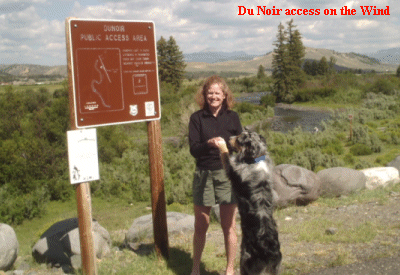 At the Du
Noir access area we fished it hard & again had only limited success on hoppers.
Nymphing (at least our patterns) were generally unsuccessful throughout this area and for
that matter, the entire state.
At the Du
Noir access area we fished it hard & again had only limited success on hoppers.
Nymphing (at least our patterns) were generally unsuccessful throughout this area and for
that matter, the entire state.A quest for the fabled Wyoming cutthroat "slam"
Sue, the dog, & I spent the better part of five days during the period July 26-30 driving roughly 1500 miles through the state of Wyoming in search of the four major cutthroat species inhabiting this state's waters.
For assistance on the trip we mainly relied on the "Fly Fisher's Guide to Wyoming". The book was invaluable for the most part, but in a number of instances we found it to be clearly off base in terms of stream/trout/water quality descriptions. Since the author highlights various lodging, restaurant, and outfitter companies in towns throughout the areas he describes, my assumption has to be that he periodically simply accepted the comments of certain of these parties without personally verifying the accuracy of the information he was given.
Here's the story.
Our trip really began at Cheyenne where we'd spent Thursday afternoon attending Frontier Days and enjoying the rodeo. Drove to Laramie afterwards that evening, had a nice dinner (Jeffrey's), & camped out at the top of the pass on an unmarked road opposite the upper Happy Jack access point. Friday we headed out on the longest (& least fishable) day of the trip. Picked up licenses & some tying material at the West Laramie Fly Store. For some unknown reason the shop operator either didn't like our looks or simply disliked us because we were from Colorado, so despite the high quality of the operation, we'll never give him further business.
Since we'd heard from a number of sources that the Miracle Mile was not fishing well, we bypassed that well known stretch of the North Platte. We did turn off at the Fort Steele public access point for the Platte just off I-80 & cast a bit into murky, warm waters for a few minutes knowing we'd have no success. Turning North on 287 at Rawlins we drove what seemed endlessly up past the Sweetwater (not) River (running slow and warm with little public access) and finally found a chance to fish in the Red Canyon of the Little Popo Agie just outside Lander. There's limited public access to this tiny trout stream, though we did enjoy finally getting to cast to the numerous 5-8 inch fish (all baby browns). Small attractor dries & black foam ants worked.
Since the main Popo Agie apparently is best accessed from the Wind River Reservation, and since we didn't feel like paying another fee, we passed on that larger river. Continued up through the reservation & finally got to the Wind River - and cursed our luck as the main stem and the East Fork were both blown out from recent thunderstorms.
Kept heading up the Wind River Canyon & camped at a great spot by the Jakey's Fork. It's a beautiful, mostly private little stream that unfortunately was totally unproductive for us. I had a couple of strikes in the evening on a wooly bugger, but we had zero success the next morning. This creek is closed from the fall through late spring to allow for spawning of the Wind's resident rainbows & browns.
The lower Wind below Dubois has a number of access points, but as it was
running cloudy in this area, we didn't attempt any fishing. It looks like a great
river being roughly the size of our Eagle, but having more undercut banks & deep
holes.  At the Du
Noir access area we fished it hard & again had only limited success on hoppers.
Nymphing (at least our patterns) were generally unsuccessful throughout this area and for
that matter, the entire state.
At the Du
Noir access area we fished it hard & again had only limited success on hoppers.
Nymphing (at least our patterns) were generally unsuccessful throughout this area and for
that matter, the entire state.
Further up the Wind with its flow diminished to perhaps 30 c.f.s. we fished at a forest service access point & caught a few scrappy rainbows albeit of modest size. A serendipitous meeting with a Dept. of Wildlife creel census taker occurred here. Since we continued to have a fear of not finding any Yellowstone strain cuts without going further North & into the Park of that name, the D.O.W. guy said that a small feeder stream named something like Lord Creek had been stocked specifically with this brand of cut. He gave us directions & we headed off on a gravelly back road (actually forest road #540). Crossing over what appeared to be an unfishable (read no flow) Lord Creek we continued on to the turnaround point roughly six miles into the forest & miraculously came upon the trailhead to what this fellow had also described as a trophy Yellowstone fishery called Pelham Lake. (As a post script regarding the name of this lake, we ordered the DeLorme Gazetteer for Wyoming late in August and note that the only lake on the forest roads in the vicinity of where we were fishing was called - more or less appropriately - "Fish Lake". So whether or not "Pelham" is a simply a local's description is something we'll have to research further sometime later.)
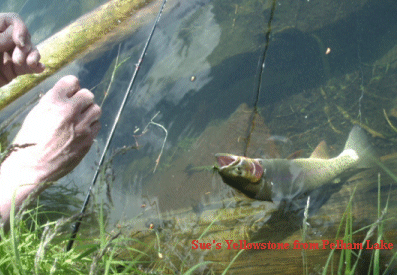 An easy fifteen minute walk took us to the shoreside trail which we followed
around for half a mile or so in an attempt to get away from a fierce wind that made
casting almost impossible. Then despite more virtually impossible casting due to
heavy bankside trees, we got additionally lucky when the fish decided that our olive wooly
buggers looked tasty. Within an hour we'd hooked a good 8-10 of these wonderful
sized and beautifully colored Yellowstone's.
An easy fifteen minute walk took us to the shoreside trail which we followed
around for half a mile or so in an attempt to get away from a fierce wind that made
casting almost impossible. Then despite more virtually impossible casting due to
heavy bankside trees, we got additionally lucky when the fish decided that our olive wooly
buggers looked tasty. Within an hour we'd hooked a good 8-10 of these wonderful
sized and beautifully colored Yellowstone's. 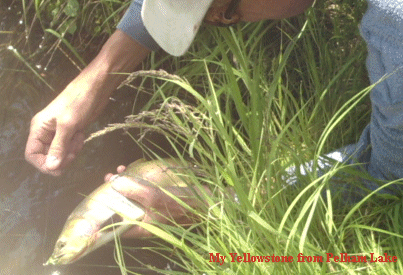 They ranged from 14-20 inches in length, and we were overjoyed
to have this species so quickly and easily recorded.
They ranged from 14-20 inches in length, and we were overjoyed
to have this species so quickly and easily recorded.
After leaving this delightful fishing we drove further up the Wind & again had some wonderful fishing on what's either the headwater area of that river or another large feeder stream. This place was located just across the highway from a campground at Shoshone Falls & we highly recommend walking up the good trail there & casting little attractor flies for the anxious-to-please rainbows & brookies.
Over the pass we drove down towards Jackson Hole. Turning left at the junction of highway 89, we looked at the Deadman's Bar access point on the Snake, but because they banned pets here, we went further downstream to the Shwabacher's Landing braided area of this river & I was fortunate enough to land a couple of 14-16 inch Snake River finespotted cuts.
Shortly after leaving this spot we turned left off 89 at the Gros Ventre
Junction and drove up the river of that name. Limited fishing access on the lower
river led us to continue up the rough gravel road to Lower Slide Lake where we camped for
the night.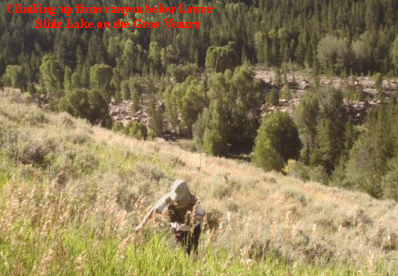 This
quake formed lake is fascinating and is much more impressive than the similarly named one
in Montana. In the morning we hiked down the truly steep canyon into the tailwater
area below this lake. Despite beautiful looking water the only fish landed was Sue's
sixteen inch Snake River finespotted. But at least now both of us had two species
out of the way.
This
quake formed lake is fascinating and is much more impressive than the similarly named one
in Montana. In the morning we hiked down the truly steep canyon into the tailwater
area below this lake. Despite beautiful looking water the only fish landed was Sue's
sixteen inch Snake River finespotted. But at least now both of us had two species
out of the way.
On the way back to highway 89 we did stop at a heavily trafficked public
access place on the lower Gros Ventre & I did land another nice fourteen incher here,
missing another couple of strikes, as did Sue. 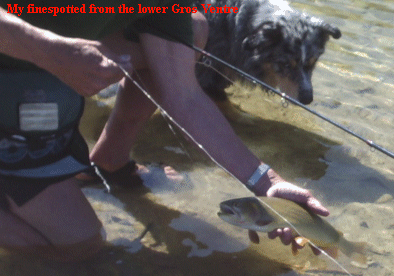 We then passed through Jackson & drove to Hoback Junction,
visited a half hour with a friend of Sue's & headed up the river of the same name.
About ten miles upstream we found the spot where Sue had successfully fished a year
earlier and we worked this tough pocket water for a couple of hours.
We then passed through Jackson & drove to Hoback Junction,
visited a half hour with a friend of Sue's & headed up the river of the same name.
About ten miles upstream we found the spot where Sue had successfully fished a year
earlier and we worked this tough pocket water for a couple of hours.
I did a lousy job of figuring it out, but eventually probably released a dozen finespotted's of smallish size. Most of mine came to a foam bodied hopper or foam black ant.
Sue on the other hand RULES the Hoback. She instinctively properly fished the tough holding areas behind sunken boulders & pulled in fish after fish. All her fish took a white winged, dark brown bodied WRS. Most of the cutthroats in this area were under twelve inches in length. It's a ruggedly beautiful, steeply descending stream that we could return to in a heartbeat and probably happily fish for 3 or 4 days.
A couple of quick things worth noting from a retrospective standpoint. We'd been advised by several sources - and found it to be absolutely true - that cutthroat's tend to exist in schools. In other words, when one fish is found there are likely to be several others in the same location despite the fact that the particular piece of holding water in question does not appear adequate to hold multiple fish.
There's also apparently no drought in the Northwest part of the state. Also from our perspective, fishing the Snake River from shore is almost impossible. It's simply too big a river. The braided areas are fun and can be relatively easily waded, but the main stream is probably dangerous and also a lot of work to wade given the kind of strong flows it displays. Float boats are best here.
Headed further down highway past Alpine & towards Afton. Passing along the Salt River, we avoided fishing this stream due to its slow, weedy appearance. Although we gassed up in Afton, this quickly became our least favorite town of all time. Everything closes up on Sunday including all the grocery outlets. One can probably guess the why of that, but we'll avoid religious slamming here. After driving though the town of Smoot, we took off up some primitive forest roads in the hopes of knocking off our last two species in one fell swoop.
This is a very interesting geological part of the state. At one point on the road is a marker indicating that here is the Tri Basin Divide. By proceeding down any one of three drainage's from this point one either finds Snake River finespotted to the North, Bonneville's to the Southwest, or Colorado River cuts. to the Southeast.
Things got difficult here - especially for me. We drove slowly down the gravel road toward the Smith Fork River which has been stocked with the elusive Bonneville species. Then pulled off & camped at the seven mile marker which also happens to be the junction of the North Fork & the main stem of this river (it's really only creek up here). The tiny stream with lots of willows can be easily waded but provides tough casting.
To make a long story shorter, Sue had four strikes & landed two small
Bonneville's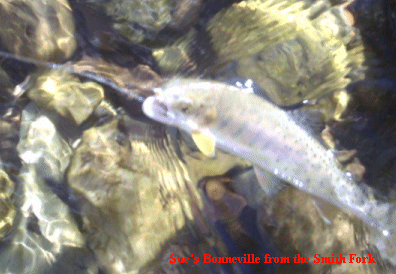 - I had
between 18-20 strikes, played five fish, and landed none despite fishing for several hours
in the evening and the following morning. My cut slam quest effectively ended right
here. It wasn't completely devastating, but my temper grew much shorter for the next
couple of days. At that point it also became a lot less fun for Sue. We both
agreed that we needed a break in the middle the next time we do a trip like this.
The pressure just got too intense, and the time constraints were mostly responsible for
the edginess on both our parts.
- I had
between 18-20 strikes, played five fish, and landed none despite fishing for several hours
in the evening and the following morning. My cut slam quest effectively ended right
here. It wasn't completely devastating, but my temper grew much shorter for the next
couple of days. At that point it also became a lot less fun for Sue. We both
agreed that we needed a break in the middle the next time we do a trip like this.
The pressure just got too intense, and the time constraints were mostly responsible for
the edginess on both our parts.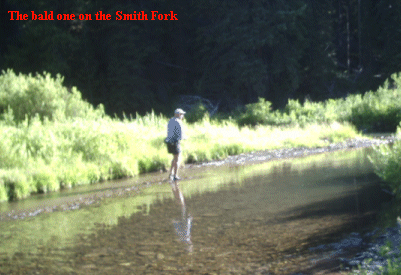
Continuing on up the Smith Fork we eventually passed over and into the La Barge drainage. This stream we also didn't fish properly - mostly due to our unfamiliarity with where the greatest numbers of fish might be holding. Trout here are either rainbows or Colorado River cuts. There are lots of fish, but they're extremely wary & difficult to entice.
We probably drove too far downstream before finally stopping and fishing
at the Sheep Creek confluence. 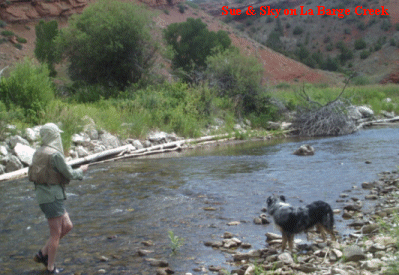 The La Barge is a gorgeous small creek with clumps of willows on the banks
and easy wading. We saw all kinds of fish. I had a dozen strikes and landed a
handful of under twelve inch rainbows & clearly had on at least two cutthroats.
Sue had a similar experience but was also unable to land a cutthroat here.
The La Barge is a gorgeous small creek with clumps of willows on the banks
and easy wading. We saw all kinds of fish. I had a dozen strikes and landed a
handful of under twelve inch rainbows & clearly had on at least two cutthroats.
Sue had a similar experience but was also unable to land a cutthroat here.
Continuing downstream we fought our way onto the stream in another few places before surrendering. For whatever reason we caught nothing but rainbows in this creek which interestingly is touted as being a primarily cutthroat stream.
Now our time limitations became even more critical. In a last attempt to try to find our missing species we headed West from La Barge towards Kemmerer and Evanston. Drove up to the "tailwater" of Lake Viva Naughton on the Ham's Fork - another incredibly ugly piece of water that appears populated by some type of trash minnow, despite this being declared as having "strong populations of 10-14 inch rainbows & browns with excellent prospects for fish over 20 inches."
Our guide book's author of that statement had to either be smoking the funny stuff at the time of the writing or simply was taking a local's word for this clear exaggeration.
Next we paralleled the Bear River for Bonneville's in another waste of time. How cutthroats could even survive in the main section of this sluggish, irrigation water clouded stream is unfathomable. OK, enough of the complaining.
Our next to last gasp was to try the Green in the town of that name. We got there early in the morning & drove out to Expedition Island. The river actually looked decent despite its too warm temperatures. The town has done a wonderful job of creating holding structure around both sides of the island, but we came up completely empty after trying dries, nymphs, & streamers. There probably are a few fish here, but the stream bottom appears to be extremely sterile. Did seen a nice hatch of trico's however.
Off we went again heading back towards home in Colorado. At the tiny town of Baggs just North of the Colorado border on highway 789, Sue went casting on a stream called the Little Snake which is purported to hold Colorado strain cutthroat. She actually caught a fish on a surface fly in this unpleasant looking stretch of the stream. It was roughly two inches long. After analysis by a fisheries biologist in Glenwood Springs the fish was unfortunately determined to not be of the trout family.
So it looks like both of us will have to revisit the Southwest corner of Wyoming to photograph at least one Colorado strain for her plus that species and the ever reluctant Bonneville for me.
Home, Main Fishing Page, , Eagle River Access, Local Ten Commandments, Successful Fly Patterns